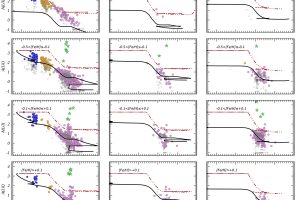Lithium abundance and stellar internal structure. The study: “The Gaia-ESO survey: Mixing processes in low-mass stars traced by lithium abundance in cluster and field stars” of L. Magrini (INAF – OA Arcetri) recently appeared on A&A

The chemical history of Lithium abundance in the Universe is very complex. This chemical element has been first produced during the Big Bang, even if in very small quantities compared with hydrogen and helium. Since then, lithium is continuously created and destroyed by several processes occurring in stellar interior. This means that the lithium abundances we observe in stars today does not reflect the primordial abundance of this element. Besides, with the only exception of very young (a few million years old) pre-main sequence stars, stellar lithium abundances are not related to the star-forming environment. Despite this, the study of lithium abundance in stars can shed an important light on the processes occurring inside the stars and on their evolution.
Lithium is in fact destroyed inside stars at a temperature of about 2.5 million degrees by proton-capture processes. During the main sequence, several phenomena occurring inside stars are responsible for carrying lithium from stellar surface to the interior where the temperature is high enough to trigger the destruction of this element. In the following evolutionary stages (such as sub-giant and giant phases), lithium in the stellar surface is even more diluted because of the processes that carry elements produced in stellar interior onto the surface.
All these phenomena can be studied with extensive measurements of lithium abundance in large sample of stars with different age, mass, and metallicity (which is the abundance of heavy elements compared with hydrogen), and then comparing the results with values predicted by models describing stellar internal structure accounting for different phenomena. This is the strategy adopted by the team of researchers led by L. Magrini (INAF – Astrophysical Observatory of Arcetri) in the study described in the paper “The Gaia-ESO survey: Mixing processes in low-mass stars traced by lithium abundance in cluster and field stars“, recently appeared in the journal Astronomy & Astrophysics. This research is based on measurements of lithium abundance obtained in the framework of the Gaia-ESO Survey for stars in 57 stellar clusters with an age between 130 million of years and 7 billion of years and field stars. The measurements of lithium abundance in stars with different age, mass and metallicity obtained by the team do not agree with the values predicted by classic models of stellar structure. A better agreement is instead observed using models that account for the internal mixing due to stellar rotation and instabilities. This demonstrate that it is important to account for these internal processes in order to reproduce the observed stellar abundances of lithium in stars with different properties and evolutive stages. The astronomers L. Prisinzano and F. Damiani of INAF – Astronomical Observatory of Palermo are among the coauthors of the paper.
The figure (click here to visualize the entire image) shows diagrams of lithium abundance (A(Li)) as a function of the stellar effective temperature. In each panel stars are sampled as a function of mass and metallicity. Stars at the main sequence turn-off are marked in blue, sub-giants in orange, and giants in pink. Upper limits are marked with gray triangles. The curves show the values predicted by theoretical models. Models including a standard description of the internal mixing processes are marked with dashed lines, models adopting accurate descriptions of the effects of rotation and instabilities with solid lines.
Mario Giuseppe Guarcello ( follow mguarce) ( youtube)
Subscribe the Youtube channel of the Astronomical Observatory of Palermo
